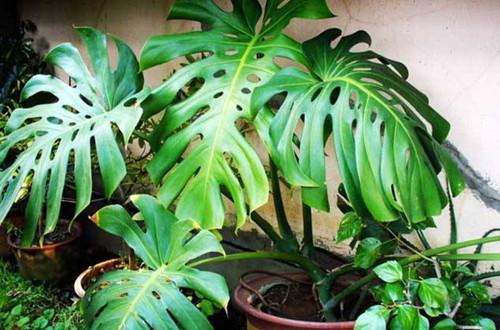Swiss cheese plant caring tips
Written by Maggie
Jan 11 2021

Swiss Cheese Plant is the first choice for beginners to plant flowers. Family potted Swiss cheese plant can be placed in the living room, stair corner, balcony, and is very easy to handle. Swiss cheese plant is a common potted plant in the south, which can grow well without spending too much time. How to care for it when its leaves have dark spots or it grows askew? Let look together of some Swiss Cheese Plant caring tips.

How to care for Swiss cheese plant having dark spots
The dark spots on the leaves of Swiss cheese plants are related to the plant growth conditions. The soil carrying the bacteria, the non-ventilated environment, the strong light and the excessive watering and fertilization in winter will affect the plant growth, resulting in the dark spots on the leaves. Move the plant to a warm, ventilated place, change the soil or use pesticides, shade in the summer, and take proper care in the winter.
The leaves of the Swiss cheese plant develop dark spots if the soil carries the bacteria. Swiss cheese plants like high temperature and high humidity. The soil contains bacteria. In a high temperature and high humidity environment, it is easy to make the root of the plant infected. If the soil is not changed for a long time, it will cause root lesions and affect plant growth. The soil can be replaced in time or treated with chlorothalonil and carbendazim.
The temperature environment will make the leaves of the Swiss cheese plant grow black spots. The Swiss cheese plant likes a cool, moist and ventilated environment. If the growing environment is cool, moist and poorly ventilated, the dust will make the Swiss cheese plant get sick. Anthracnose can cause plant leaves to become spotted and spread widely if left unchecked for a long time. Trim away the diseased leaves, spray the plant with a deworming agent, and move the plant to a ventilated area.
Too much light can damage the leaves, causing them to develop spots. Swiss cheese plants are not fast in the sun, afraid of strong light direct sun, strong light will stimulate the leaves, and affect the leaves to extend seriously. The tissue of the leaves will be sunburned, the leaves will grow spots. Move the leaves to a warm and ventilated place for maintenance in time and do shade work in summer.
Too much watering and too much fertilization in winter will also make the leaves of The Swiss cheese plant grow black spots. In cold winter, the Swiss cheese plant will be in dormancy state when it is below 10 degrees. Reduce watering and stop fertilizing during dormancy, or the roots will rot or burn, affecting the health of the plant and leading to leaf spots.

How to care for Swiss cheese plant growing askew
The askew growth of Swiss cheese plants may be caused by too fast growth or not deeply rooted. When the askew is caused by too fast growth, the plants need to be pruned properly, and then the plants should be pruned regularly during cultivation. If your roots are not deep enough to skew them, cut off some of the roots and bury the roots a little deeper.
1. Overgrowth
Swiss cheese plant is also known as Penglai banana and Coryneum, belonging to the Araceae family. It is often used as a pot plant for cultivation. The Swiss cheese plant grows sideways during cultivation and may be caused by too fast growth. When the plant grows too fast, the weight on it increases, causing the plant to skew, and the plant needs to be pruned properly.
When pruning, it is not only necessary to cut off the yellow leaves and rotten leaves on the plant, but also need to cut off too long branches and vines on the plant. After pruning, appropriately apply medicine to the wound disinfection. It is better to place flower pots in the environment of indoor half shade, ventilated places for a period of time, and we need to undertake clipping regularly.
2. Deep roots
Swiss cheese plants may also be long and crooked because the root is not deep. The underground foundation of the plant is not firm, the overgrown branches will appear top-heavy feeling, after a long time the plant will be skewed. At this time, part of the root of the Swiss cheese plant needs to be cut off, and then the root of the plant needs to be buried deeper.
If the root of the plant is well treated, you can set a prop in the pot so that the branches are set along the prop, or you can move the pot to the wall to raise the plant, which will also straighten the plant. Swiss cheese plants like to grow in a warm and humid environment. It is necessary to water the plants in time to keep the soil moist.

Latest Updated
- Benefits of Bugleweed - 7 Science-backed Health Benefits
- Bugleweed Dangers & Side Effects - Is It Poisonous?
- How to Plant Evergreen Trees - What You Should Know
- When to Plant Evergreens - Grow Guide for Evergreen Trees
- 12 Wonderful Evergreen Shrubs for Your Garden
- 12 Popular Evergreen Plants with Pictures for Beginners
- When And How To Prune A Lilac Bush Like a Pro
- How to Grow & Care for Lilac Vine (Hardenbergia Violacea)
- Japanese Lilac Tree (Syringa Reticulata) Care & Propagation Guide
- Shumard Oak Pros and Cons - What to Know
Popular Articles
- Winter maintenance of Antirrhinum Majus
- How to Grow Terminalia Mantaly Tree
- How to Grow and Care for Crossostephium Chinense
- How to grow Antirrhinum Majus in spring
- Peristeria Elata (Dove Orchid) Profile: Info & Care Guide
- Underwatered Snake Plant (Sansevieria Trifasciata) - Signs And How To Fix
- How to Care for Brazilian Jasmine Plant (Mandevilla Sanderi)
- How to Grow & Care for Graptopetalum Purple Delight in Summer
- Rosa Chinensis (China Rose): Plant Growing & Care Tips
- How to Care for Baby Sun Rose (Aptenia Cordifolia)